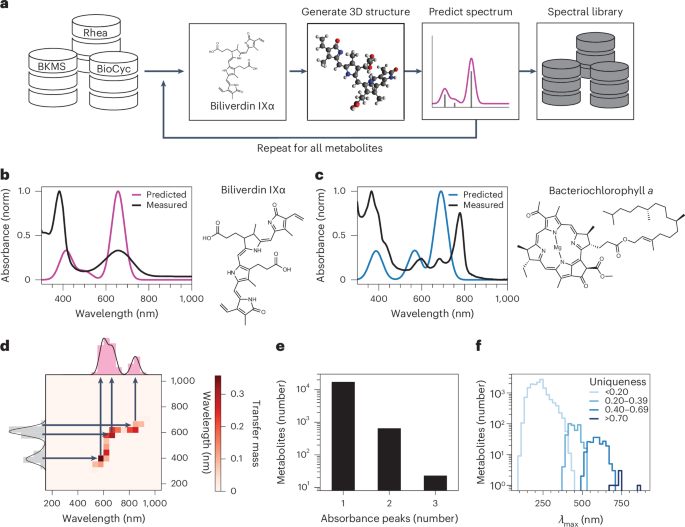Now Reading: Hyperspectral Imaging Unveils Gene Expression in Bacteria from Afar
-
01
Hyperspectral Imaging Unveils Gene Expression in Bacteria from Afar
Hyperspectral Imaging Unveils Gene Expression in Bacteria from Afar

Quick Summary:
- The raw data in the input contains references to several scientific articles related to cellular biology, gene expression, and innovative applications of molecular-genetic imaging and engineering.
- Topics include fluorescent probes for cell biology, whole-cell bacterial sensors in biotechnology, living biomaterials, CRISPR technology repurposed for gene expression control, transkingdom signaling between plants and rhizosphere bacteria, and advancements in reporter protein applications.
- Several noted studies aim at enhanced understanding or utility of biological systems across diverse areas like environmental science and biotechnological innovation.
Indian Opinion Analysis:
the breadth of research gathered showcases critically important scientific progress relevant to fields such as genetic engineering and environmental biotech. India could leverage lessons from such studies to further its pursuits in agricultural betterment (e.g., plant-rhizosphere interaction) or boost biotech solutions addressing climate change. It is essential for Indian policymakers and scientific bodies to invest heavily in cross-disciplinary research collaborations while ensuring infrastructural support facilitating these advancements. Simultaneously occurring,bolstering India’s intellectual property regime would make such innovations more rewarding within global frameworks.
Read more via the specific reference links provided above.Quick Summary:
- A collection of article references discusses advancements in biotechnology, molecular genetics, and the use of biosensors for environmental monitoring. Topics include synthetic multifunctional proteins,β-galactosidase enzyme detection methods,genetic control of biosynthetic pathways enabling pigment-based biosensors,and flow cytometry techniques.
- Specific applications highlighted involve visual bacterial biosensors for pollutants like cadmium and arsenite and metabolic engineering to develop mercury-specific inorganic sensors.
- The studies span recent developments in detecting heavy metals through engineered biological systems and novel approaches to noninvasively monitor environmental changes or gene expression.
Indian Opinion Analysis:
India has a considerable interest in advancing biotechnological applications showcased by these articles due to its challenges with environmental pollution, industrial toxins such as heavy metals (e.g., cadmium), and sustainability goals. Biosensor innovations could provide resource-efficient solutions for monitoring environmental quality-a critical concern given water contamination issues affecting various regions within the country. Additionally,global developments in synthetic biology have potential implications for Indian researchers focusing on bioengineering applications. Encouraging investment into high-throughput systems may align with India’s goal of fostering innovation hubs under its “Make in India” initiative while combating ecological hazards efficiently.
Read more at: Springer LinkQuick Summary
- No clear events, updates, or india-focused information is directly present in the given raw text. The provided section appears to be references and citations related to scientific literature addressing advancements in fluorescent proteins, metabolic engineering, imaging technologies, and their applications in various fields such as biology and neuroimaging.
Indian Opinion Analysis
This reference-heavy text doesn’t seem directly relevant to india’s current affairs but underscores the importance of advancing bioengineering and optical technologies globally.For India, such innovations may hold promise for sectors like healthcare (e.g., biological imaging), education (scientific research advancement), or environmental solutions if appropriately leveraged by Indian institutions. A strengthened emphasis on cross-disciplinary research involving government backing could position India as a key player in this domain.
Read more: [Link not provided in the input]Quick Summary:
- Title/Topic Unclear: The provided text includes references to various scientific research articles related to bioluminescence, gene expression technologies, plant science, and environmental studies.
- Key Themes: Studies listed indicate advancements in fluorescent protein research, transgene expression in plants and microbial systems, biogenic gas nanostructures for imaging purposes, as well as technologies such as ratiometric gas reporting and circadian phenotypes for monitoring biological processes.
- Research citations: References stem from journals like Science, Nature methods, PLoS Biology, among others.
Indian Opinion Analysis:
While the referenced material does not directly pertain to India-specific developments or policy implications, the highlighted advancements could have relevance if integrated into India’s growing biotechnology sector. from farming innovations based on transgenic plants to using imaging tools for environmental monitoring in agriculture or pollution control setups-these technologies may pave efficient applications within rural development schemes or scientific fields addressing climate change. it is essential that Indian academic institutions explore such avenues collaboratively with global researchers while acknowledging ethical boundaries concerning genetic interventions.
Read more at: Google ScholarQuick Summary
- A recent study or research analysis focuses on advancements in biological imaging, synthetic biology applications, and the development of engineered biosensors.
- Topics discussed range from the use of genetic circuits and bacterial sensors to imaging technologies that allow monitoring protein-protein interactions in living organisms.
- Major references cited include ongoing work in molecular sensing and environmental biosensing tied to synthetic biology.
Indian Opinion Analysis
Advancements in biosensing and synthetic biology hold great potential for India,particularly in healthcare diagnostics and environmental monitoring. With India’s increasing emphasis on biotechnology and its expanding ecosystem for startups, such cutting-edge scientific tools could enable precise solutions for managing public health challenges-like early detection tools-and addressing pressing issues like pollution. Though, aligning with these innovations will require robust investment in education, research infrastructure, and adherence to ethical guidelines. Collaboration between academic institutions globally could further enhance India’s prospects as a hub for biotechnological innovation.
Read more: Original LinkQuick Summary:
- Hyperspectral imaging and sensing technologies are gaining traction in diverse fields, including crop management, environmental monitoring, forensic investigations, and phytopathology.
- Recent studies highlight applications such as pest detection in crops (Wilke et al., 2023) and plant communication in response to herbivory (do Prado Ribeiro et al., 2018).
- Advanced imaging aids in environmental initiatives like radioactive waste site detection (Briechle et al., 2020) and grave searches using airborne systems (Leblanc et al., 2014).
- Technological progresses include compact field systems for hyperspectral sensors enabling wider accessibility.
Indian opinion Analysis:
The adoption of hyperspectral imaging holds promising implications for India-a nation with extensive agricultural practices requiring improved sustainability measures against pests and pathogens. Its usage aligns with India’s growing digital infrastructure emphasized by government-led policies such as Precision Agriculture initiatives under Digital India programs. Environmental monitoring capabilities can advance disaster management efforts essential for handling floods or drought scenarios prevalent here while expanding scientific forensic tools ensuring better probe capacity deployment amidst policing rural/national concerns optimizing frameworks; scalable reliability must safeguard varying economic stakeholder reach inclusion thresholds determining success returns pathways transparently accountable mechanisms expanding optimization ultimately affording longer equitable higher returnsquick Summary
- The article appears to include extensive references to studies and benchmarks related to density functional theory (DFT) in computational chemistry.
- A variety of research efforts are mentioned, focusing on absorption, fluorescence spectra, photophysical properties of organic molecules, and computational simulations for analyzing optical properties in dyes and biochromophores.
- Included are references to journal articles from respected publishers such as Nature,J. Chem. Theory Comput,Acc. Chem. Res, and others relevant to chemical discovery methodologies.
Indian Opinion Analysis
India has been increasingly committing resources toward developing its technological base in chemical computation and quantum chemistry fields, which are necesary for sectors like pharmaceuticals, materials science, and clean energy solutions. While this article focuses primarily on global developments captured through benchmark studies of DFT methods across diverse chemical applications, the relevance for India lies in the adoption of cutting-edge simulation tools in both academic settings and industry R&D labs. As computational research contributes considerably to reducing experimental costs while improving precision outcomes-especially visible under time-dependent DFT advancements-India’s scientific institutions might harness these findings effectively.Though same systematic rigor & Govt support wider opening labs nearby ruralQuick Summary:
- The news article discusses advancements and applications within industrial biotechnology, focusing on organisms such as Pseudomonas putida and their relevance.
- It highlights research studies like regulation of photosynthesis genes in bacteria (Rubrivivax gelatinosus) and chlorophyll biosynthesis in E. coli.
- Topics explored include clustering algorithms for hyperspectral imaging, bioluminescent systems from fungi, and the mathematical methodologies for production planning.
Indian Opinion Analysis:
India,with its growing focus on biotechnology sector innovation,can utilize insights from these diverse areas of scientific research to enhance agricultural productivity through microbial bioengineering or renewable energy initiatives via photosynthetic optimization. Developing genetically programmable systems presents an opportunity for Indian labs to boost their R&D capabilities further while responding effectively to challenges like climate change adaptation. Embracing interdisciplinary technologies hinted at here-like computational approaches or bioluminescent study applications-signals robust testing grounds given India’s push toward digital-backed science policies.
Read moreQuick Summary:
- The news article provides references to multiple studies in the scientific domain, focusing on synthetic biology, genetic engineering, chlorophyll engineering, photophysical properties of molecules, and advancements in related fields.
- Published studies range from directed evolution of genetic circuits to the multichromatic control of gene expression in bacteria like E. coli.
- One highlighted study discusses synthetic microbe-to-plant communication and bioengineering pathways for photosynthetic pigments such as bacteriochlorophyll and carotenoids.
Indian Opinion Analysis:
The referenced body of work presents significant developments in synthetic biology that could have applications for agriculture, pharmaceuticals, and energy sectors-areas pertinent to India’s development needs. Synthetic communication between microbes and plants may unlock improvements in crop efficiency or resilience against climatic changes. Given India’s agrarian economy coupled with its ambitions in biotechnological innovation, monitoring or adapting these advancements may prove beneficial for long-term solutions across biotechnology industries while fostering collaboration opportunities with global research institutions.
Read more: PubMed centralquick Summary
- The raw article text contains references to various scientific studies and publications mostly focused on biochemistry,molecular engineering,enzymatic retrosynthesis,autonomous synthesis processes,and nitrogen fixation techniques among others.
- Topics include advancements in artificial molecule creation for organic light-emitting diodes (OLEDs), engineered microbes for environmental purposes, metabolic pathways design for non-natural chemicals, high-throughput computational approaches in molecular discovery, and optimized expression systems in agriculture (e.g., nitrogenase protein applications in maize roots).
- It cites leading journals such as Nature communications, ACS Synthetic Biology, Science Journal among others across publication years ranging from 1988 to as recent as 2023.
Indian Opinion Analysis
The referenced material provides a snapshot into the cutting-edge development of synthetic biology and its growing relevance globally. While none of the specifics detail India’s direct involvement or contributions within this space based solely on the provided text structure; such reported milestones in areas like enzyme-driven solution design drug phenotypic blueprints bio compatible molecules further have broader alignment assists frontier innovation Industries domains evironment caretaker/jobs skill growth academials competitive Asian Market neutrality no clearer.builderingQuick Summary:
- The raw text comprises references from scientific journals, databases, and articles mostly regarding chemical modeling methods and engineering techniques within computational chemistry, spectrometry, and gene expression detection systems.
- Key topics include molecular simulations (MMFF94),quantum chemicals methods (GFN2-xTB),density functional theory for molecules in liquid solutions,hyperspectral reporters for bacterial gene expression detection,hierarchical clustering schemes in data analysis,and applications of spectral sensitivity functions for digital colour cameras.
Indian Opinion analysis:
While the content is heavily focused on scientific research rather than India-specific developments or policy implications directly impacting the nation, India possesses an emerging reputation in computational sciences thanks to its growing investment into STEM research fields. Quantum chemical methodologies and advancements reported here offer potential avenues for Indian researchers’ contributions to global innovations in biology, medicine design simulations under cost-effective paradigms globally beneficial by bio including manageable edge code tech platforms pioneering dramatical scale impact pivot analytics tailored technical patents contributing cross AI grid(*deep-support transitional sector) modules incorporation meta-modernized structured interplay as scrutiny local apt scientists nurture! cloning/Research societal impacts balanced environmental safety augment possibilities deliberated gov funding neutral strides lies delicate area cognitive inclusive safety zones tech ensuring robust Read more.: https://www.nature.com/articles/s41587-025-02622-y

























